Mac Studio with M1 UItra review: A look at the future power of Apple Silicon
Apple's high-end Mac Studio brings phenomenal power in a very small enclosure. It is very clearly not for everybody, but every Mac user should be excited about what it portends for the very-near future.
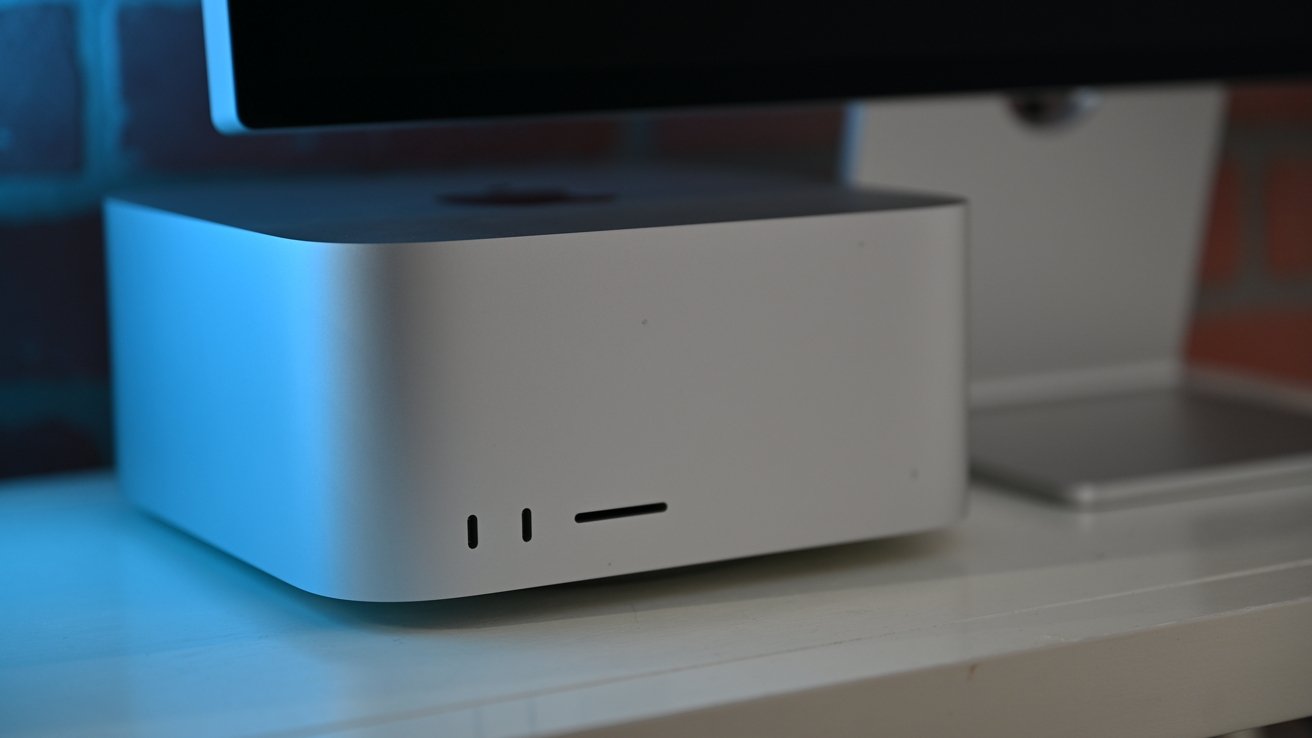
When Apple revealed the Mac Studio in its "Peek Performance" special event, it framed the newest Mac product as a workhorse. Instead of a Mac Pro, power users who need high levels of performance could use a considerably enhanced Mac mini, one that offers all of the promise of an upper-tier Apple Silicon chip.
It resulted in what looked like an almost-triple decker Mac mini that boasted more than enough power to keep content creators happily working away.
Rumors hinted at a Mac mini refresh with a better chip, with the M1 Pro and M1 Max borrowed from the 16-inch MacBook Pro. They didn't foresee Apple bulking up the Mac mini in this way until the Friday before launch.
And that surprise was impressive by itself. We'll mostly be talking about the Mac Studio with M1 Ultra in this review, as the discussion about the Mac Studio with M1 Max is a little wider.
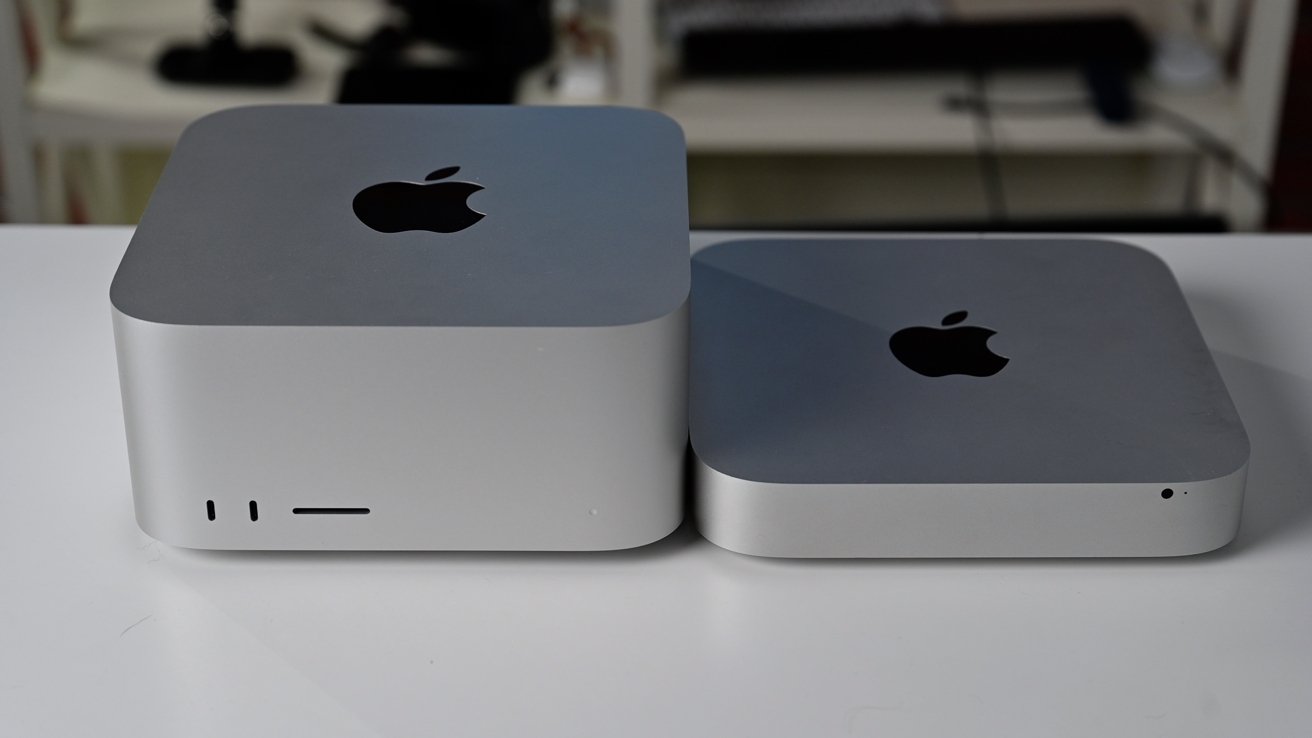
Mac Studio vs Mac mini
The aluminum enclosure has the same styling, with it having the footprint of a rounded square, a flat top with distinct edges, and a black Apple logo on the top. The Mac Studio is more than twice the height of the Mac mini at 3.7 inches to 1.4 inches, but the two models both have the same width and depth of 7.7 inches.
Obviously, that added aluminum and other internal adjustments means there's more weight. The M1 Max edition weighs 5.9 pounds, but the M1 Ultra version, with its copper heat sink tips the scales at 7.9 pounds.
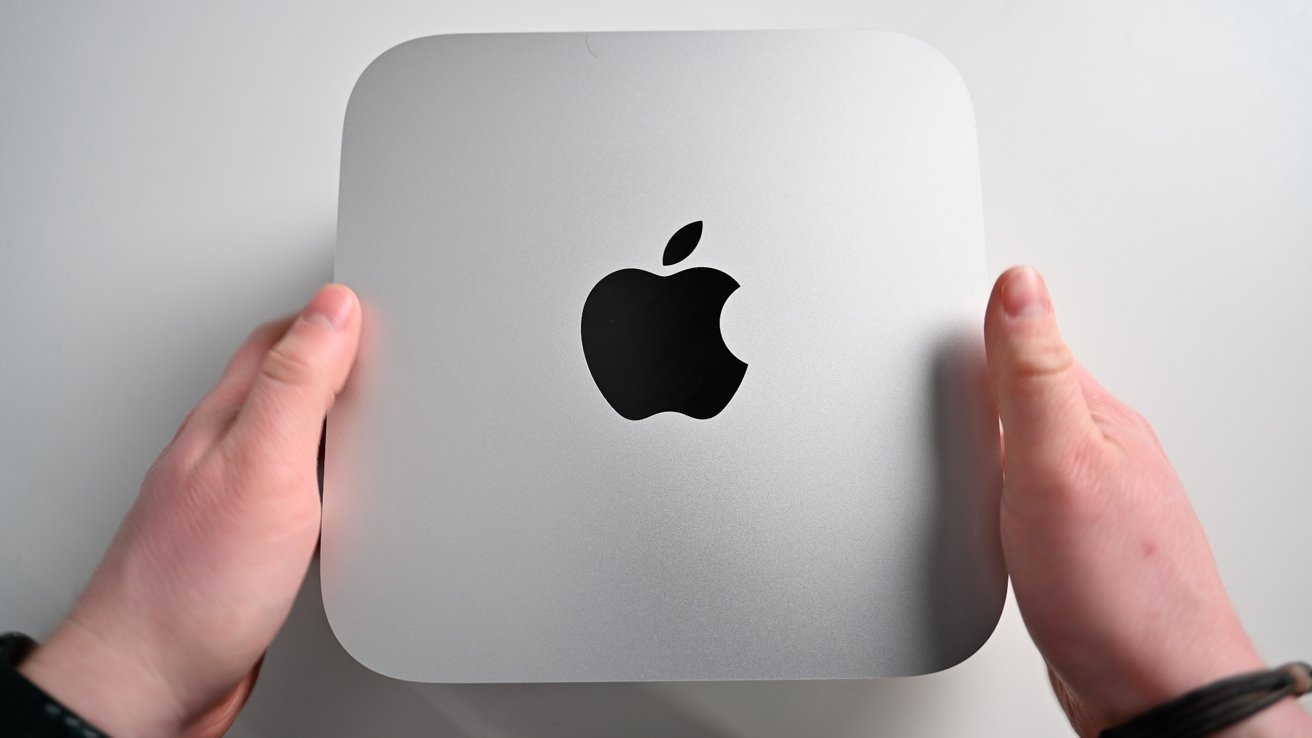
Top down shot of the Mac Studio
This use of copper is a practical consideration. In general, copper is a better heatsink material of its density than aluminum. While aluminum has about 30% the density of copper, aluminum also has about 60% of the conductivity that copper does given the same basic construction of the heat sink.
Aluminum is significantly less expensive than copper, though. For the same mass, copper costs about three times as much.
Like the Mac mini, there's a small power indicator dot in the front-left corner, but rather than leaving users with a completely blank face, Apple departs from the theme with a few additions.
On the front of the Mac Studio, there are two USB-C ports for the M1 Max version, two Thunderbolt 4 ports for the M1 Ultra edition.
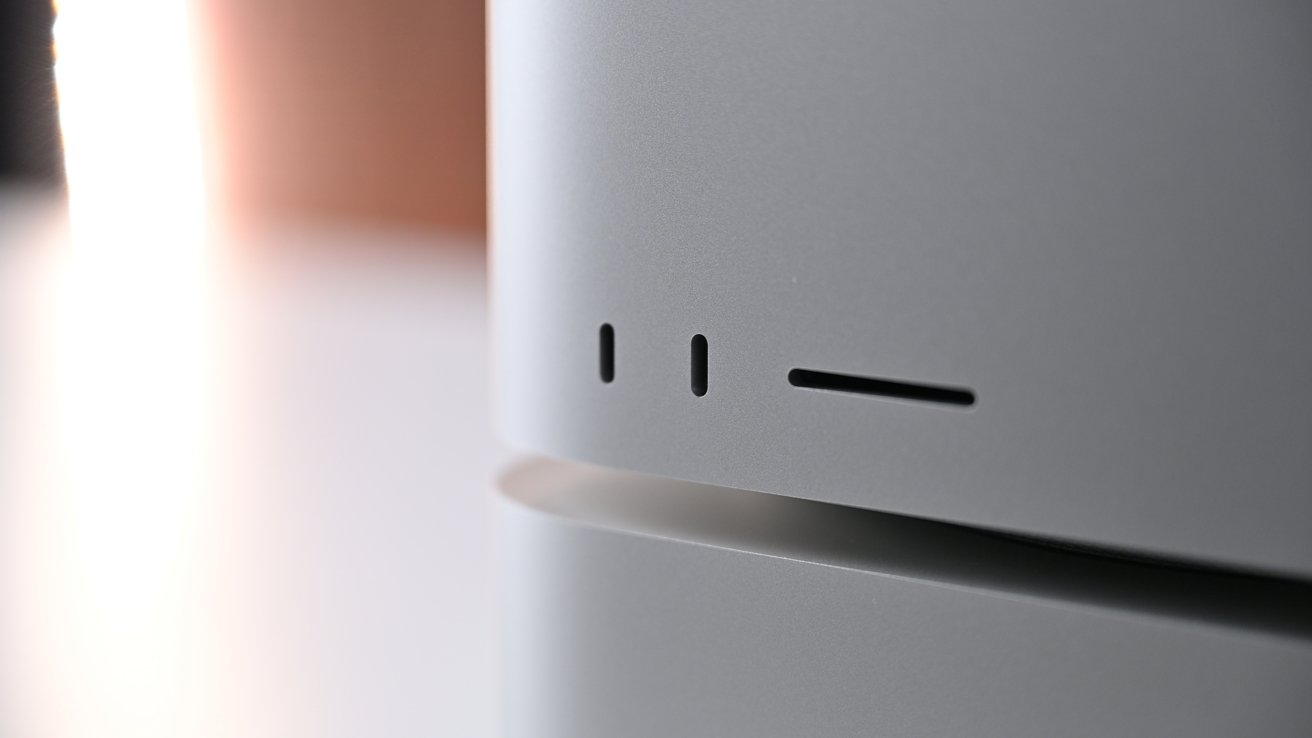
Front Mac Studio ports
There's also an SDXC Class II card reader on the front, a component that was lost in the shift to Apple Silicon on the Mac mini. However, mounting it and the two USB-C ports of one flavor or another to face the user makes them easily accessible whenever they are needed.
Much like the Mac mini, the rest of the ports are around the back, but things have improved here as well. There's a quartet of Thunderbolt 4 ports, as well as two USB-A, a 10-gigabit Ethernet connection, HDMI, and the headphone jack.
The left-hand power input of the Mac mini has been switched to a bigger connection in the middle of the Mac Studio. The power button has also made a move, shifting from the rear right to the rear left corner.
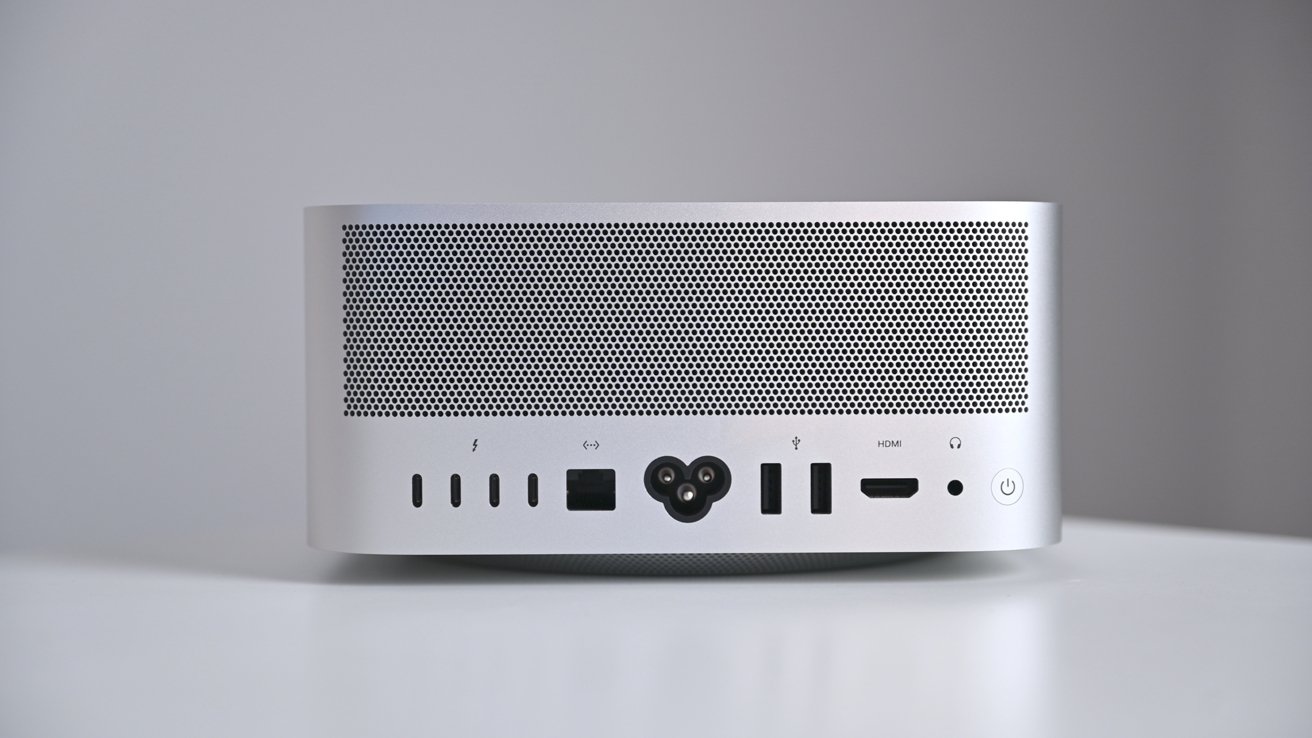
Rear Mac Studio ports
Despite the extra size at the back, the ports are all aligned to the base edge, underneath a very large perforated grille. Apple claims there are about 4,000 holes in use here, all to help with the shifting of air for its new cooling system.
And, for whatever the reason, the "new Mac smell" is different. Not unpleasantly so, but it's not the same. Might be the copper heatsink, might be some manufacturing impact of the recycled materials in the enclosure.
As it pertains to the acoustics of the device, we had a baseline of 36 dBa of ambient noise measured with a Kanomax model 4431 audiometer, with the test gear on the desk at hand-height, about at a distance of about three feet. The M1 Max Mac Studio hit 37 dBa at idle, and 41 dBa under load.
The M1 Ultra Mac Studio while idle hit 39 dBa idle, and 42 dBa under load.
Strictly from a noise standpoint, in the same 36 dBa room and at about the same distance, the 2018 Intel i9 MacBook Pro at idle was about 40 dBa, and under heavy load was about 45 dBa. The 16-inch Intel-based MacBook Pro hit a maximum of 44 dBa.
And, perhaps a more direct comparison is the M1 Mac mini. While idle, the M1 Mac mini is indistinguishable from ambient when idle, and 40 dBA under load. The Mac mini is much quieter, but that makes sense, given that has either half, or one-quarter the CPU area and heat as its taller cousin.
From a noise perspective, this puts the Mac Studio solidly in between lower-end Apple Silicon hardware, and Intel gear.
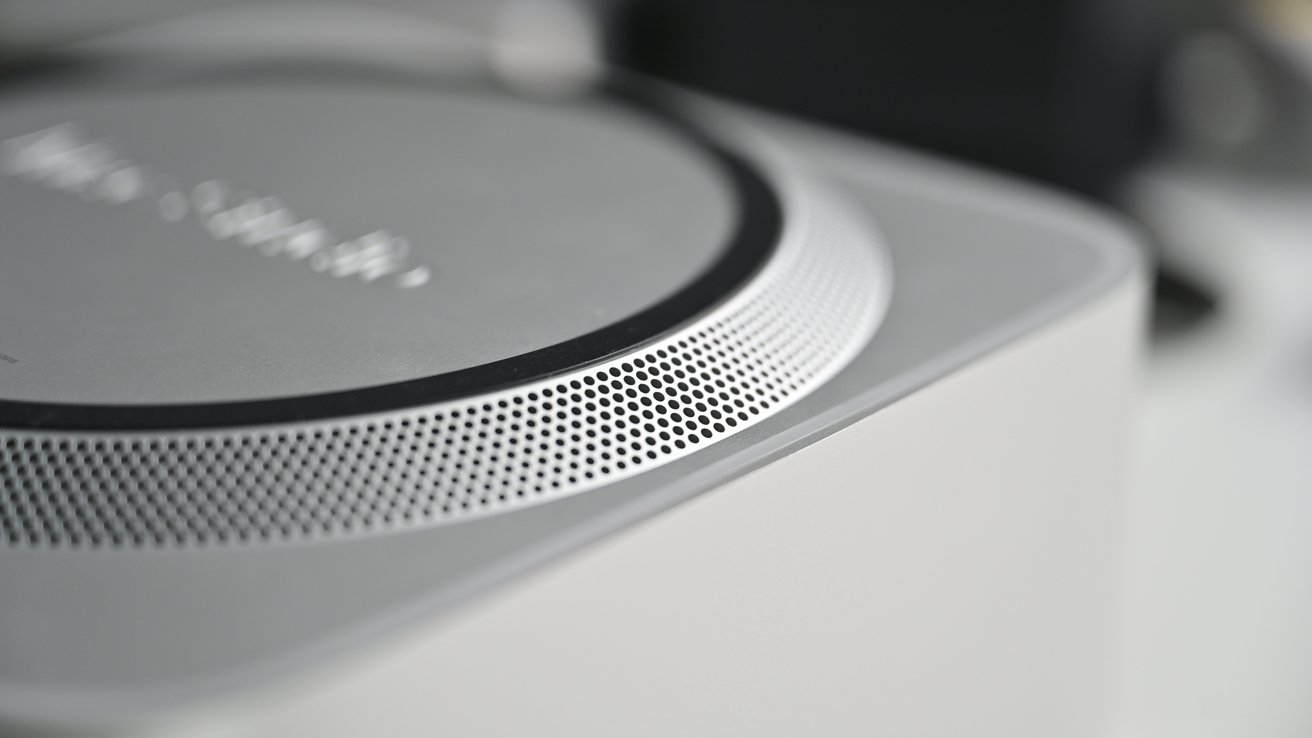
Intake vents on the back of the Mac Studio
This all said, Fans in Apple equipment have a tone and a character that has been about the same for the last decade -- until now, at least. The fan in the M1 Ultra Mac Studio isn't quite the same, and it may take a very brief period of adjustment, if its replacing a desktop or laptop of relatively recent purchase.
Like the different new Mac smell, the change isn't irritating -- it's just different.
The M1 Max did make it into one version of the Mac Studio, but so a new, fourth, M1 chip, the M1 Ultra.
Instead of coming up with a brand new chip design from scratch or making significant alterations to an existing one, Apple simply increased the core counts by effectively sticking two chips onto one bit of silicon.
Using the M1 Max as its base on a 5-nanometer process, Apple used a die-to-die interconnect it calls UltraFusion to get two Max chips communicating on a low-latency bus with each other. Connected by more than 10,000 signals, there's up to 2.5 terabytes per second of bandwidth used for the two chips to speak to each other.
Unlike most multiple chip situations, this practically results in almost exactly double the benchmarking and performance of one chip. And all told, this includes a total of 20 CPU cores, made up of 16 performance cores and four efficiency cores.
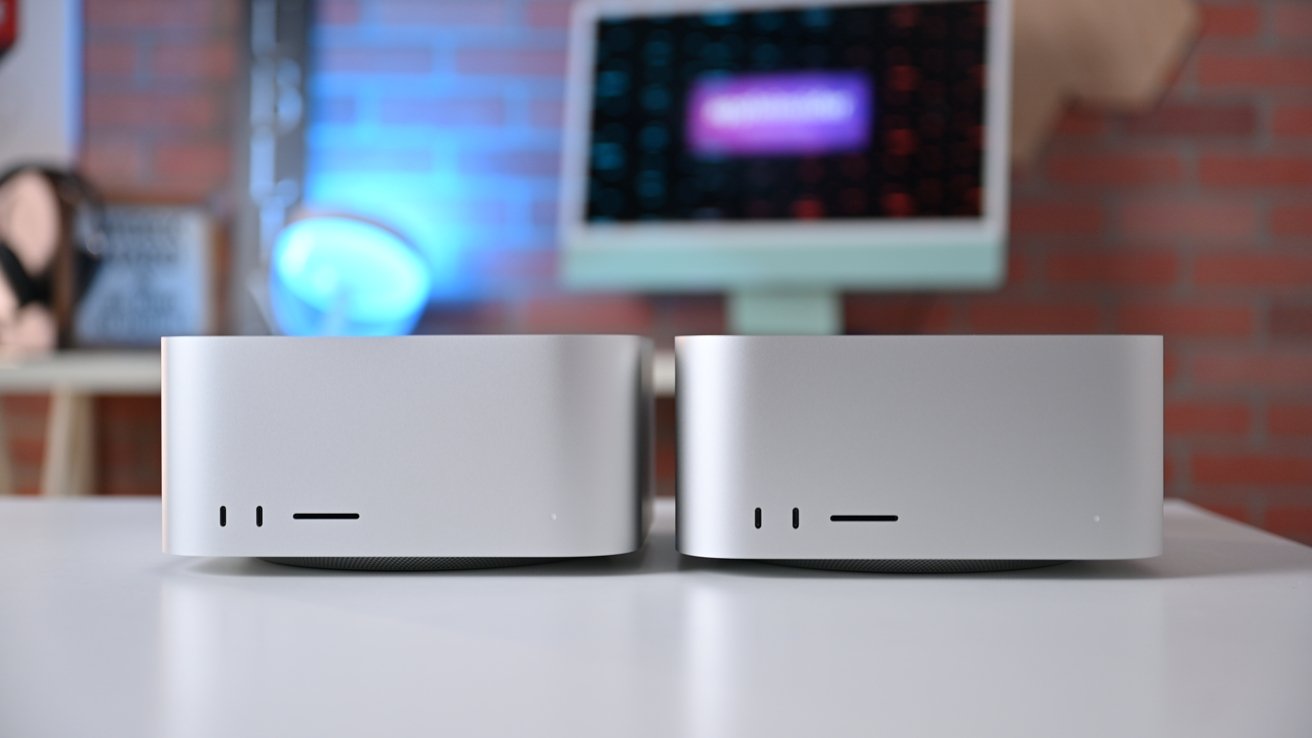
M1 Max and M1 Ultra versions of the Mac Studio
There's also a doubling of cores in Apple's self-designed GPU, with a base option of 48 cores and an upgraded 64-core version -- and this is all addressable to developers as one GPU. That's not all, as there's a doubling of Neural Engine cores to 32.
This doubling effect also applies in other ways. For example, the amount of Unified Memory for one M1 Max chip at 32GB or 64GB translates to 64GB and 128GB on the M1 Ultra. Memory bandwidth of 400GB/s on the M1 Max turns into 800GB/s on the M1 Ultra too.
The doubling and how Apple uses the UltraFusion technology effectively doubles the PCI-E allocation channels available to the machine. Beyond the higher RAM limit, this is practically why the front ports are Thunderbolt 4 on the configuration we're testing today, and USB 3.2 type C on the front of the M1 Max version.
For creative professionals, the Media Engine in the M1 Max makes a return for handling video encoding and decoding, but again it's doubled. There are two video decode engines, four video encode engines, and four ProRes encode and decode engines on the silicon.
This all said, benchmarks are helpful, to a point. They're never doing precisely the same calculations that you're doing, and the key for any given user as far as interpreting these things go, is to figure out which line up the best for any given use case.
This is why we always throw a pile of benchmarks at new Apple hardware once we got them in our studio, testing everything from Geekbench to 8K video exports.
Starting with our browser test, we ran the Speedometer benchmark from BrowserBench that tests a machine's ability to run web applications. The M1 Max managed 293 runs per minute while the M1 Ultra earned 292 runs per minute. Effectively the same when the margin of error is considered.
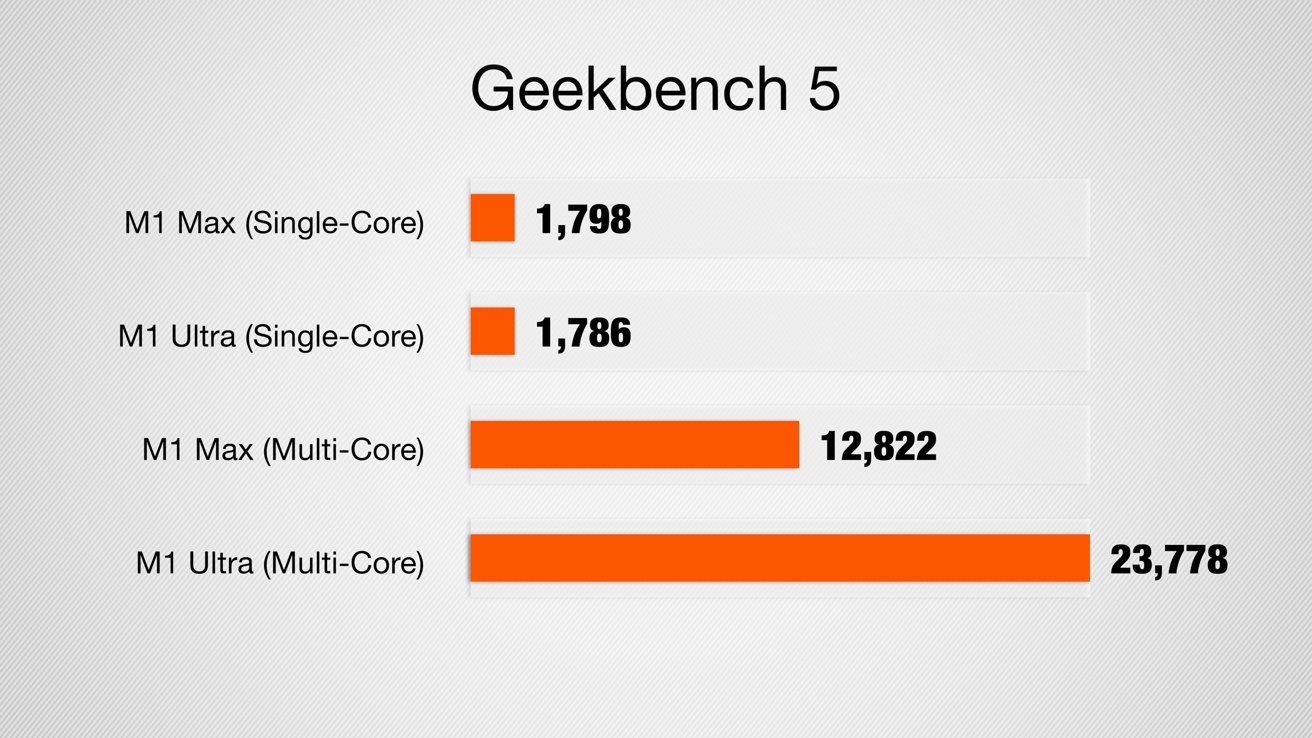
Geekbench 5 results on Mac Studio
In Geekbench 5, our M1 Max Mac Studio delivered a 1,798 single-core and a 12,822 multi-core result. The M1 Ultra variant pulled a similar 1,786 single-core score, as expected, but an impressive 23,778 multi-core score, and that all comes down to the 20 cores found in the M1 Ultra.
Cinebench revealed similar numbers. The M1 Max version scored 1,535 and 12,389 on the single and multi-core R23 tests respectively while the M1 Ultra earned a 1,535 and a 24,210 on the single and multi-core tests.
Affinity Photo now has its own benchmark that tests vector performance on the CPU and raster performance, taxing both the CPU and GPU. We looked primarily at the combined scores for CPU and the GPU. The M1 Max scored a 947 for the CPU and a 22,537 for the GPU. The M1 Ultra came in with a 1,879 for the CPU and a 33,668 on the GPU.
Geekbench's Compute graphics test echoed those results. When running on Metal, the Geekbench 5 Compute test scored a 60,629 on the 24-core M1 Max GPU and a 91,938 on the 48-core M1 Ultra GPU. A roughly 50 percent increase for the M1 Ultra graphics.
Ungine Heaven is started to become a bit dated, and it still runs under Rosetta rather than natively on Apple silicon, but this is still useful to measure the impact of Rosetta. When this gaming-specific benchmark runs, the M1 Max averaged 94 frames per second with a 2,371 score and a max frame rate of 186.4. The M1 Ultra earned an average frame rate of 102 FPS, a score of 2,584, and a maximum frame rate of 187 FPS.
These maxed out at roughly the same frame rate, but the M1 Ultra scored just a bit higher and kept the frame rate just a bit higher throughout.
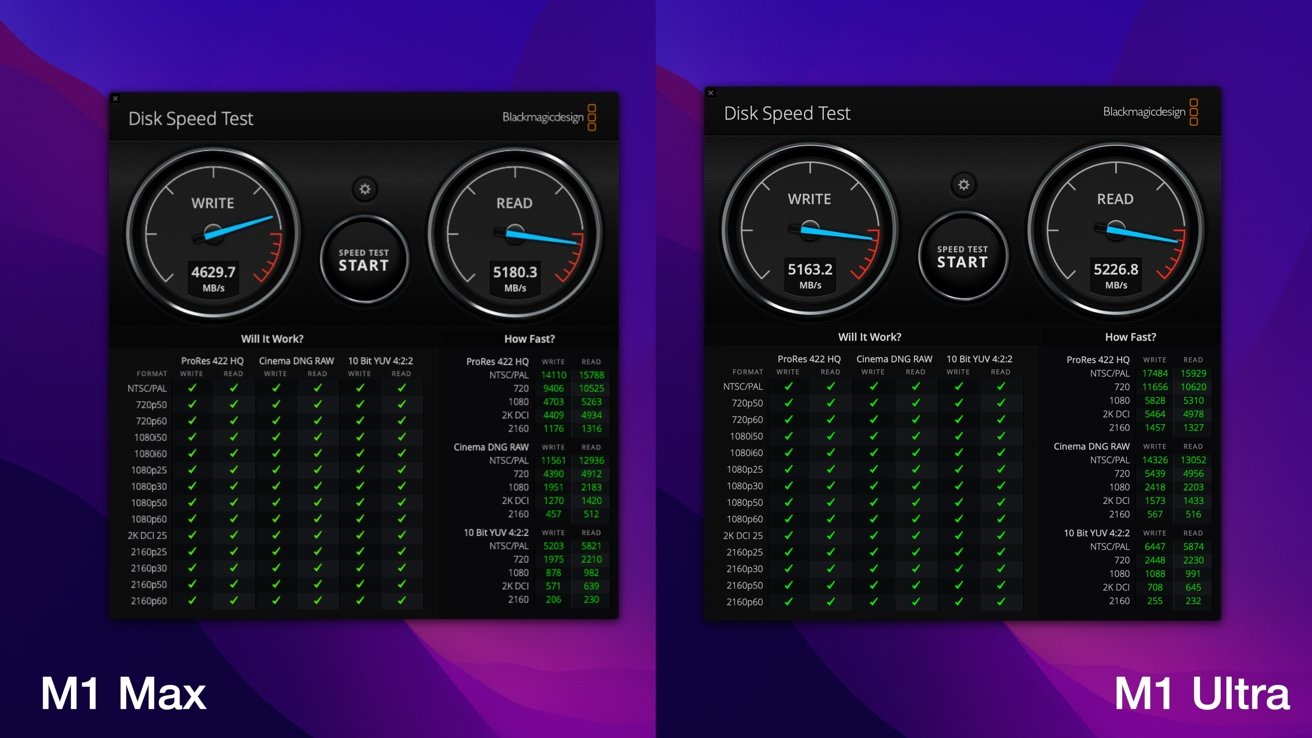
Blackmagic disk speed results
Testing the built in storage, our 512GB SSD on the M1 Max earned a 4629.7MB/s write speed and a 5180.3 MB/s read speed on the BlackMagic Disk Speed Test. This was below the 1TB module in our M1 Ultra machine that earned a 5163.2 MB/s write speed and a 5226.8 MB/s read speed. The 2TB version hit 6403 MB/s write, and 6709.8 MB/sec read.
The SSD speeds come down to the impact of parallelization. Grossly simplified, the more chips of flash media the machine has, the faster read and write operations will perform.
In Final Cut Pro, we exported multiple videos and saw varying degrees of performance difference. Unless you're doing very high end production, you likely won't see a huge difference in video performance, even with the additional encode and decode engines on the M1 Ultra. So, let's do some.
When exporting a one-hour 4K video as "Apple compatible," both machines took a nearly identical 18 minutes to finish. When we exported an uncompressed 4K video in Apple ProRes that was 16 minutes long, it took a minute and 14 seconds on the M1 Ultra and a minute and 30 seconds on the M1 Max.
Wrapping up the video testing, we encoded 8K video uncompressed from Apple ProRes, and the M1 Max took five minutes and five seconds while the M1 Ultra took four minutes and 42 seconds.
What you do not get, though, is Nvidia 3090-beating speeds, as Apple promised. Apple's graph as it pertains to the Nvidia 3090 card is misleading. For whatever the reason, Apple looks like it truncated the max performance of the Nvidia card, instead of a far likelier extension of the graph.
That said, all the headlines trumpeting this fact were a bit disingenuous too. Tomb Raider is still Rosetta, and as such, there is a performance penalty versus native code which was conveniently omitted from those tests.
There's a lot of blame to go around, here. Apple's vague and incomplete graphs serve nobody. On the other hand, other testers not disclosing the conditions of the test, or if something is tested with Rosetta and deprecated graphics is on equally shaky ground.
But we get it. Headlines and subheads like "Apple lied" are flashy, and get attention. Welcome to the attention economy.
Besides, the street price of that 3090 is ludicrous, not even including the cost of the power you'll need to run it. You can get an entire M1 Max Mac Studio for what a 3090 costs these days, or you're already halfway to buying the M1 Ultra version.
So, the bottom line to that conversation is that Apple's M1 Ultra is not a head-to-head performer as it compares to a full-throttle 3090 under maximum load. But, that's also almost exclusively a gaming card, and I find it highly unlikely that anybody will buy a Mac Studio for gaming.
Nobody should swap a $28,000 Mac Pro for the Mac Studio, not even for the M1 Ultra one. That $28,000 Mac Pro is in most regards a hair faster than the high-end Mac Studio. Plus, it has those PCI-E slots, and a much, much higher RAM limit.
The real question in 2022 isn't if you should replace that $28,000 investment with a Mac Studio -- because there is absolutely no need to do that. Instead, the question asking if you should swap out a $6000 Mac Pro with a $5000 Mac Studio with upgrades at purchase that will make your life better, is what high-powered creatives should be considering.

Geekbench 5 Single-Core results for Mac Studio with M1 Ultra and Mac Pro with 8-core Intel Xeon.
Across multiple CPU benchmarks, you'll find the same story when you pit the M1 Ultra against the 8-core Intel Xeon in the base-model Mac Pro. That story is one of massive domination.

Geekbench 5 Multi-Core results for Mac Studio with M1 Ultra and Mac Pro with 8-core Intel Xeon.
Geekbench 5 illustrates this quite well, with its single-core test putting the M1 Ultra at 1,786 points, versus the 1,016 the Mac Pro musters. It's the same story for multi-core, with the M1 Ultra's 23,778 almost three times that of the Mac Pro's 8,019.

Geekbench 5 Compute results for Mac Studio with M1 Ultra and Mac Pro with 8-core Intel Xeon.
On the Compute test, the M1 Ultra more than doubles the Mac Pro's output, at 91,938 to 41,772. Bearing in mind that the Xeon chips are meant to seem "impressive" to normal users, this difference is mind-blowing, even with the few-years difference between the CPUs.

Cinebench R23 Single-Core results for Mac Studio with M1 Ultra and Mac Pro with 8-core Intel Xeon.
The story is practically the same for Cinebench R23. Single-core results weigh in the M1 Ultra's favor at 1,535 points to 970 for the Mac Pro, making it a slightly closer match than on Geekbench.

Cinebench R23 Multi-Core results for Mac Studio with M1 Ultra and Mac Pro with 8-core Intel Xeon.
On the multi-core side, the M1 Ultra's 24,210 score is again more than double the Mac Pro's result of 9,294. For Affinity Photo's Combined CPU test, the M1 Ultra's 1,879 is more than three times that of the Mac Pro, which manages 619.

Affinity Photo Combined CPU results for Mac Studio with M1 Ultra and Mac Pro with 8-core Intel Xeon.
The disparity in results can be explained quite easily. On the single-core side, the M1 Ultra's cores are simply better than what the base Mac Pro's Xeon uses.
The difference is further magnified in the multi-core results, since there's way more cores at play in the Mac Studio. It's inevitable that a 20-core chip with better per-core performance can outpace another processor running just eight cores.
Whether or not any particular benchmark we ran directly applies to your use case, Apple's Mac Studio is a brutally fast computer. After a point that varies for any given user, that speed boost just doesn't matter.
The decision to buy a computer hinges not just on budget, but it also should depend on how often you're waiting for your computer, instead of the other way around. Over the course of the day, if you're sitting back and waiting for a job to get done, maybe it's time to take a step or two up in computing grunt than what's on or under your desk now.
On the other hand, it won't get your email faster or browse the web any quicker. We've said this before, but a new and brutally fast computer won't make you a better writer, photo editor, or videographer.
There are folks that can and will soak up all the speed, diminutive size, and power efficiency, though.
As we generally have, we had the incredible privilege of testing the Mac Studio alongside some active-duty folks, and some other people who intend to use the machine for defense-related time-sensitive number-crunching. Without delving too much into specifics about what their key uses are, they're going to take their now highly-optimized for Apple Silicon software, slap it on the new hardware, and effectively halve their processing time on massive jobs.
In our discussions while testing, some of the fleet of Mac Pros they bought for their processing purposes are going to be reassigned to other locations. There's excitement about the low power, heat, and volume of the machines, and there are already engineering brackets and shock rigs for use in what's called "commercial off the shelf" -- COTS -- situations.
In one use-case that this writer is familiar with from ages of yore that feels at this point like a previous lifetime, we're told that versus what's in that space now, a Mac Studio doing that job will shave off a full kilowatt of power and heat-removal requirements off of a small, enclosed space. And, it will do it in less than a tenth of the volume and 5% of the weight of what's in that space now.
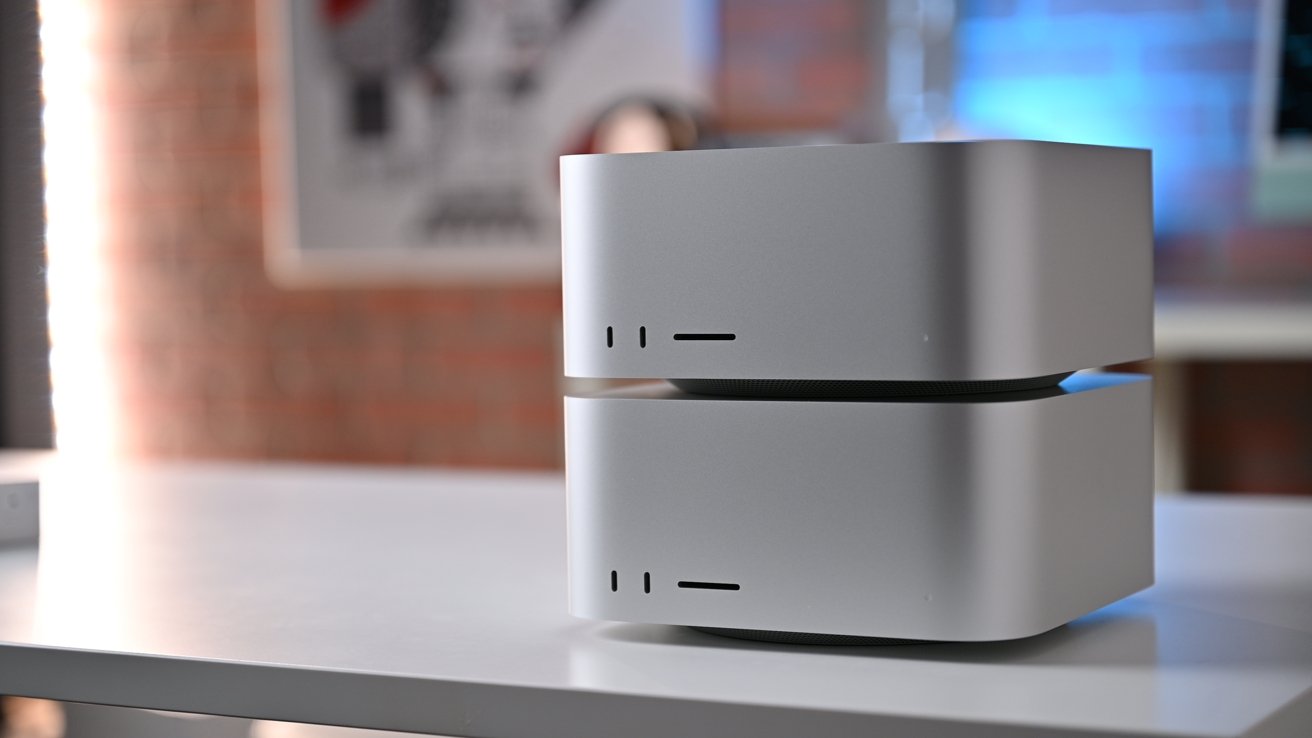
Stacked M1 Max and M1 Ultra Mac Studios
We've spoken to roadies and tech crew for the music industry, who are looking forward to replacing bulky hardware with a Mac Studio and a rack-mounted PCI-E enclosure.
Just in the last few days, we've seen one large local enterprise give a few of the Mac Studio models to folks that have a shared office space, with monitors and keyboards on desks in a smaller office footprint than they had in 2020.
This all said, Apple's Mac Pro has always had a place. There were some interesting accessories for the cylindrical 6,1 Mac Pro, given it's small footprint. We're expecting many of the same are being frantically engineered right now, and we're looking forward to what pops out the other end.
And if anybody in manufacturing is listening, somebody needs to make a lucite Mac Studio stand. It's time for Cube 2.0.
Apple literally called this system modular at the release event, and we're not sure what they mean by that. There's no real modularity here unless you count stacking a few up on top of each other and using Universal Control to do different jobs.
In our testing, we did find that eGPU enclosures can be repurposed for Apple Silicon-supported PCI-E cards. Vendors like Sonnet have Thunderbolt PCI-e enclosures and system more geared to cards that aren't as massive as graphics ones.
They're obviously extra expenses, but they do work. That might be what Apple is talking about when it says "modular," but that's a funny Cupertino definition of it, we suppose.
There's been some talk in recent days about how the SSD modules are slotted, and "not user accessible." For some reason. this has translated into yet another "Apple lied" splashy YouTube headline suggesting that the Mac Studio is upgradeable.
So, we chose to not cover it at the time, because the claims made no sense. Instead, we asked Apple about it.
The actual truth is that the slots are only intended for Apple's own repairability and supply-side configurability, a source within Apple's corporate structure not authorized to speak on behalf of the company told us. This allows Apple to keep the number of motherboard versions it needs to manufacture down, and simplifies the repair supply chain.
From another source within Apple, we were told that there are "no plans" to offer upgrade modules to customers. Apple-certified technicians supported by a shop will use a serialization tool on the drive modules, we're told.
Any given M.2 or SATA SSD have flash media, and an on-board controller. Apple's modules in this case appear to be bare flash that leverage controllers in the Mac Studio itself.
The 7,1 Mac Pro had user-upgradeable SSD modules sold by Apple, needing the upgrader to use Apple's Configurator tool. There are still no third-party options, two years later. Other machines, like the 2016 MacBook Pro with Touch Bar had a slot for storage, and Apple never offered an upgrade for that.
The RAM is still fully soldered down, as is the CPU. Beyond the remotest possibility of a third-party offering something for storage, this machine is not practically upgradeable, and there is no chance that beyond storage it can be.
Don't buy it assuming that the Mac Studio is practically upgradeable based on some irresponsible and inaccurate videos that got cranked out on Friday. Slots do not necessarily mean upgradeability.
Instead, buy what configuration you think you'll need in a few years. You won't be sorry in the long term, but your wallet will hurt in the short -- unless you're using somebody else's money.
But, as the years progress, the distance between a similarly-shaped peak computing power line and my actual computing needs are greater than where they've historically been. I like computing power, I just don't need a truckload of it.
I'm not a videographer. I don't handle megabytes, gigabytes, or terabytes (depending on the decade) of data sorting, processing, and storing much anymore. My days of computational-heavy image processing and subject identification from just a handful of pixels are mostly over.
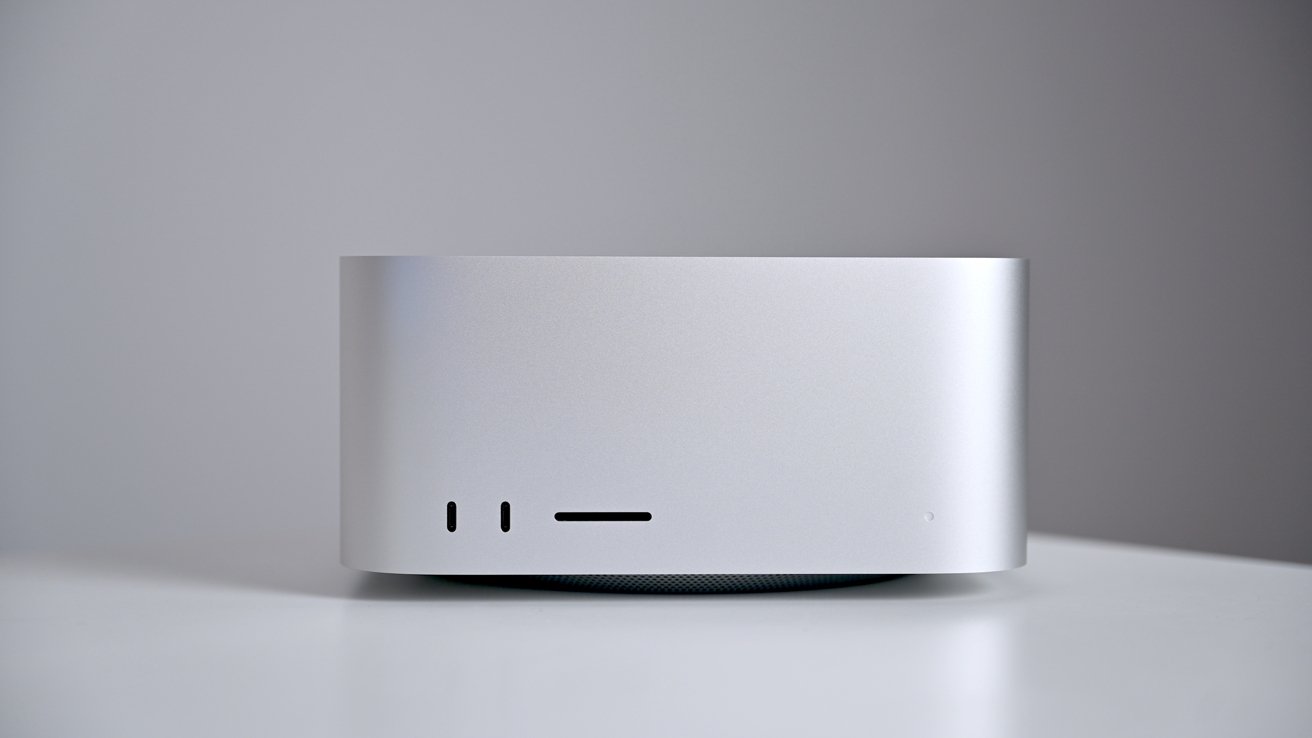
Apple's 2022 Mac Studio
And, even the more-recent fluid dynamic calculations that I've had to do are a black box for me. Instead of doing them locally. I enter data into a system, and a computer on another end of the Internet spits out what I need.
But, periodically, outside of my time at AppleInsider, I'm presented with that massive database, a confounding fluid flow problem, some kind of weird stoichiometry math, or those images again, and I'm asked to help. I don't personally need a computer that can crunch them in real-time, but I'm glad the folks that I'll work with have that option while running macOS at the same time. And, I'm pretty sure AppleInsider's multimedia team appreciate theirs now.
Like the 14-inch MacBook Pro and 16-inch MacBook Pro updates from 2021, Apple engineering led by Apple Silicon continues to light a fire under Intel and AMD to improve and not lose ground. They both work better and harder with close competition -- and so does Apple.
The entire industry is lifted up by things like the 12th generation Intel chip, AMD's latest Threadrippers, and Apple Silicon. This benefits consumers and enterprise alike, with faster iterations, and technologies migrating down from the high-end to the computer as appliance crowd.
The Mac Studio is a glimpse at the future. Its power will filter down -- eventually -- to lower-end gear. But that day is not today, and if you have a Mac Studio, enjoy the preview of tomorrow's power.
Bring on the Mac Pro, Apple. You have folks ready for it.
Pros:
Otherwise, wait and see what trickles down the line in the next few years.
Score: 4.5 out of 5
Stay tuned to our Mac Studio Price Guide for the latest specials and product availability.
Read on AppleInsider

When Apple revealed the Mac Studio in its "Peek Performance" special event, it framed the newest Mac product as a workhorse. Instead of a Mac Pro, power users who need high levels of performance could use a considerably enhanced Mac mini, one that offers all of the promise of an upper-tier Apple Silicon chip.
It resulted in what looked like an almost-triple decker Mac mini that boasted more than enough power to keep content creators happily working away.
Rumors hinted at a Mac mini refresh with a better chip, with the M1 Pro and M1 Max borrowed from the 16-inch MacBook Pro. They didn't foresee Apple bulking up the Mac mini in this way until the Friday before launch.
And that surprise was impressive by itself. We'll mostly be talking about the Mac Studio with M1 Ultra in this review, as the discussion about the Mac Studio with M1 Max is a little wider.
Mac Studio review: Specifications
| Mac Studio with M1 Max | Mac Studio with M1 Ultra | |
|---|---|---|
| Base price | $1,999 | $3,999 |
| Dimensions (inches) | 7.7 x 7.7 x 3.7 | 7.7 x 7.7 x 3.7 |
| Weight (pounds) | 5.9 | 7.9 |
| Chip | M1 Max | M1 Ultra |
| CPU cores | 10 | 20 |
| RAM | 32GB, expandable to 64GB | 64GB, expandable to 128GB |
| GPU | Apple-designed 24-core, upgradable to 32-core | Apple-designed 48-core, upgradable to 64-core |
| Neural Engine | 16-core | 32-core |
| Media Engine | Video decode engine, 2 x Video encode engines, 2 x ProRes encode and decode engines | 2 x Video decode engines, 4 x Video encode engines, 4 x ProRes encode and decode engines |
| SSD | 512GB, 1TB, 2TB, 4TB, 8TB | 1TB, 2TB, 4TB, 8TB |
| Front ports | 2 x USB-C, 1 x SDXC | 2 x Thunderbolt 4, 1 x SDXC |
| Rear Ports | 4 x Thunderbolt 4 ports, 2 x USB-A, 1 x HDMI, 1 x 10GB Ethernet, 1 x 3.5mm headphone | 4 x Thunderbolt 4 ports, 2 x USB-A, 1 x HDMI, 1 x 10GB Ethernet, 1 x 3.5mm headphone |
| External Video | 4 x 6K60Hz over USB-C plus 1 4K60 over HDMI. | 4 x 6K60Hz over USB-C plus 1 4K60 over HDMI. |
| Audio | Built-in speaker, 3.5mm headphone jack, HDMI | Built-in speaker, 3.5mm headphone jack, HDMI |
| Wi-Fi | Wi-Fi 6 | Wi-Fi 6 |
| Bluetooth | 5.0 | 5.0 |
Mac Studio review: Bigger than the Mac mini, with the same desk footprint
The obvious physical point of comparison for the Mac Studio is the Mac mini, and in more ways than one. For a start, if you ignore the appearance of a Mac mini that's had one too many protein shakes, the Mac Studio bears a considerable likeness to its stablemate.
Mac Studio vs Mac mini
The aluminum enclosure has the same styling, with it having the footprint of a rounded square, a flat top with distinct edges, and a black Apple logo on the top. The Mac Studio is more than twice the height of the Mac mini at 3.7 inches to 1.4 inches, but the two models both have the same width and depth of 7.7 inches.
Obviously, that added aluminum and other internal adjustments means there's more weight. The M1 Max edition weighs 5.9 pounds, but the M1 Ultra version, with its copper heat sink tips the scales at 7.9 pounds.

Top down shot of the Mac Studio
This use of copper is a practical consideration. In general, copper is a better heatsink material of its density than aluminum. While aluminum has about 30% the density of copper, aluminum also has about 60% of the conductivity that copper does given the same basic construction of the heat sink.
Aluminum is significantly less expensive than copper, though. For the same mass, copper costs about three times as much.
Like the Mac mini, there's a small power indicator dot in the front-left corner, but rather than leaving users with a completely blank face, Apple departs from the theme with a few additions.
On the front of the Mac Studio, there are two USB-C ports for the M1 Max version, two Thunderbolt 4 ports for the M1 Ultra edition.

Front Mac Studio ports
There's also an SDXC Class II card reader on the front, a component that was lost in the shift to Apple Silicon on the Mac mini. However, mounting it and the two USB-C ports of one flavor or another to face the user makes them easily accessible whenever they are needed.
Much like the Mac mini, the rest of the ports are around the back, but things have improved here as well. There's a quartet of Thunderbolt 4 ports, as well as two USB-A, a 10-gigabit Ethernet connection, HDMI, and the headphone jack.
The left-hand power input of the Mac mini has been switched to a bigger connection in the middle of the Mac Studio. The power button has also made a move, shifting from the rear right to the rear left corner.

Rear Mac Studio ports
Despite the extra size at the back, the ports are all aligned to the base edge, underneath a very large perforated grille. Apple claims there are about 4,000 holes in use here, all to help with the shifting of air for its new cooling system.
And, for whatever the reason, the "new Mac smell" is different. Not unpleasantly so, but it's not the same. Might be the copper heatsink, might be some manufacturing impact of the recycled materials in the enclosure.
As it pertains to the acoustics of the device, we had a baseline of 36 dBa of ambient noise measured with a Kanomax model 4431 audiometer, with the test gear on the desk at hand-height, about at a distance of about three feet. The M1 Max Mac Studio hit 37 dBa at idle, and 41 dBa under load.
The M1 Ultra Mac Studio while idle hit 39 dBa idle, and 42 dBa under load.
Strictly from a noise standpoint, in the same 36 dBa room and at about the same distance, the 2018 Intel i9 MacBook Pro at idle was about 40 dBa, and under heavy load was about 45 dBa. The 16-inch Intel-based MacBook Pro hit a maximum of 44 dBa.
And, perhaps a more direct comparison is the M1 Mac mini. While idle, the M1 Mac mini is indistinguishable from ambient when idle, and 40 dBA under load. The Mac mini is much quieter, but that makes sense, given that has either half, or one-quarter the CPU area and heat as its taller cousin.
From a noise perspective, this puts the Mac Studio solidly in between lower-end Apple Silicon hardware, and Intel gear.

Intake vents on the back of the Mac Studio
This all said, Fans in Apple equipment have a tone and a character that has been about the same for the last decade -- until now, at least. The fan in the M1 Ultra Mac Studio isn't quite the same, and it may take a very brief period of adjustment, if its replacing a desktop or laptop of relatively recent purchase.
Like the different new Mac smell, the change isn't irritating -- it's just different.
Mac Studio review: M1 Ultra engineering
The biggest feature of the Mac Studio is its selection of systems-on-chips. Apple could've easily stuck with adding the M1 Pro and M1 Max in a Mac mini enclosure and called it a day.The M1 Max did make it into one version of the Mac Studio, but so a new, fourth, M1 chip, the M1 Ultra.
Instead of coming up with a brand new chip design from scratch or making significant alterations to an existing one, Apple simply increased the core counts by effectively sticking two chips onto one bit of silicon.
Using the M1 Max as its base on a 5-nanometer process, Apple used a die-to-die interconnect it calls UltraFusion to get two Max chips communicating on a low-latency bus with each other. Connected by more than 10,000 signals, there's up to 2.5 terabytes per second of bandwidth used for the two chips to speak to each other.
Unlike most multiple chip situations, this practically results in almost exactly double the benchmarking and performance of one chip. And all told, this includes a total of 20 CPU cores, made up of 16 performance cores and four efficiency cores.

M1 Max and M1 Ultra versions of the Mac Studio
There's also a doubling of cores in Apple's self-designed GPU, with a base option of 48 cores and an upgraded 64-core version -- and this is all addressable to developers as one GPU. That's not all, as there's a doubling of Neural Engine cores to 32.
This doubling effect also applies in other ways. For example, the amount of Unified Memory for one M1 Max chip at 32GB or 64GB translates to 64GB and 128GB on the M1 Ultra. Memory bandwidth of 400GB/s on the M1 Max turns into 800GB/s on the M1 Ultra too.
The doubling and how Apple uses the UltraFusion technology effectively doubles the PCI-E allocation channels available to the machine. Beyond the higher RAM limit, this is practically why the front ports are Thunderbolt 4 on the configuration we're testing today, and USB 3.2 type C on the front of the M1 Max version.
For creative professionals, the Media Engine in the M1 Max makes a return for handling video encoding and decoding, but again it's doubled. There are two video decode engines, four video encode engines, and four ProRes encode and decode engines on the silicon.
Mac Studio review: Benchmarking and speed
This review focuses on the higher-end of the Mac Studio, but discussing it in parallel with the M1 Max version is useful.This all said, benchmarks are helpful, to a point. They're never doing precisely the same calculations that you're doing, and the key for any given user as far as interpreting these things go, is to figure out which line up the best for any given use case.
This is why we always throw a pile of benchmarks at new Apple hardware once we got them in our studio, testing everything from Geekbench to 8K video exports.
Starting with our browser test, we ran the Speedometer benchmark from BrowserBench that tests a machine's ability to run web applications. The M1 Max managed 293 runs per minute while the M1 Ultra earned 292 runs per minute. Effectively the same when the margin of error is considered.

Geekbench 5 results on Mac Studio
In Geekbench 5, our M1 Max Mac Studio delivered a 1,798 single-core and a 12,822 multi-core result. The M1 Ultra variant pulled a similar 1,786 single-core score, as expected, but an impressive 23,778 multi-core score, and that all comes down to the 20 cores found in the M1 Ultra.
Cinebench revealed similar numbers. The M1 Max version scored 1,535 and 12,389 on the single and multi-core R23 tests respectively while the M1 Ultra earned a 1,535 and a 24,210 on the single and multi-core tests.
Affinity Photo now has its own benchmark that tests vector performance on the CPU and raster performance, taxing both the CPU and GPU. We looked primarily at the combined scores for CPU and the GPU. The M1 Max scored a 947 for the CPU and a 22,537 for the GPU. The M1 Ultra came in with a 1,879 for the CPU and a 33,668 on the GPU.
Geekbench's Compute graphics test echoed those results. When running on Metal, the Geekbench 5 Compute test scored a 60,629 on the 24-core M1 Max GPU and a 91,938 on the 48-core M1 Ultra GPU. A roughly 50 percent increase for the M1 Ultra graphics.
Ungine Heaven is started to become a bit dated, and it still runs under Rosetta rather than natively on Apple silicon, but this is still useful to measure the impact of Rosetta. When this gaming-specific benchmark runs, the M1 Max averaged 94 frames per second with a 2,371 score and a max frame rate of 186.4. The M1 Ultra earned an average frame rate of 102 FPS, a score of 2,584, and a maximum frame rate of 187 FPS.
These maxed out at roughly the same frame rate, but the M1 Ultra scored just a bit higher and kept the frame rate just a bit higher throughout.

Blackmagic disk speed results
Testing the built in storage, our 512GB SSD on the M1 Max earned a 4629.7MB/s write speed and a 5180.3 MB/s read speed on the BlackMagic Disk Speed Test. This was below the 1TB module in our M1 Ultra machine that earned a 5163.2 MB/s write speed and a 5226.8 MB/s read speed. The 2TB version hit 6403 MB/s write, and 6709.8 MB/sec read.
The SSD speeds come down to the impact of parallelization. Grossly simplified, the more chips of flash media the machine has, the faster read and write operations will perform.
In Final Cut Pro, we exported multiple videos and saw varying degrees of performance difference. Unless you're doing very high end production, you likely won't see a huge difference in video performance, even with the additional encode and decode engines on the M1 Ultra. So, let's do some.
When exporting a one-hour 4K video as "Apple compatible," both machines took a nearly identical 18 minutes to finish. When we exported an uncompressed 4K video in Apple ProRes that was 16 minutes long, it took a minute and 14 seconds on the M1 Ultra and a minute and 30 seconds on the M1 Max.
Wrapping up the video testing, we encoded 8K video uncompressed from Apple ProRes, and the M1 Max took five minutes and five seconds while the M1 Ultra took four minutes and 42 seconds.
What you do not get, though, is Nvidia 3090-beating speeds, as Apple promised. Apple's graph as it pertains to the Nvidia 3090 card is misleading. For whatever the reason, Apple looks like it truncated the max performance of the Nvidia card, instead of a far likelier extension of the graph.
That said, all the headlines trumpeting this fact were a bit disingenuous too. Tomb Raider is still Rosetta, and as such, there is a performance penalty versus native code which was conveniently omitted from those tests.
There's a lot of blame to go around, here. Apple's vague and incomplete graphs serve nobody. On the other hand, other testers not disclosing the conditions of the test, or if something is tested with Rosetta and deprecated graphics is on equally shaky ground.
But we get it. Headlines and subheads like "Apple lied" are flashy, and get attention. Welcome to the attention economy.
Besides, the street price of that 3090 is ludicrous, not even including the cost of the power you'll need to run it. You can get an entire M1 Max Mac Studio for what a 3090 costs these days, or you're already halfway to buying the M1 Ultra version.
So, the bottom line to that conversation is that Apple's M1 Ultra is not a head-to-head performer as it compares to a full-throttle 3090 under maximum load. But, that's also almost exclusively a gaming card, and I find it highly unlikely that anybody will buy a Mac Studio for gaming.
Mac Studio review: Those Mac Pro compares
There have been a lot of comparisons to the $28,000 Mac Pro configuration. We get it -- it's a flashy compare, and illustrates what Apple can do after it unchained itself from Intel.Nobody should swap a $28,000 Mac Pro for the Mac Studio, not even for the M1 Ultra one. That $28,000 Mac Pro is in most regards a hair faster than the high-end Mac Studio. Plus, it has those PCI-E slots, and a much, much higher RAM limit.
The real question in 2022 isn't if you should replace that $28,000 investment with a Mac Studio -- because there is absolutely no need to do that. Instead, the question asking if you should swap out a $6000 Mac Pro with a $5000 Mac Studio with upgrades at purchase that will make your life better, is what high-powered creatives should be considering.

Geekbench 5 Single-Core results for Mac Studio with M1 Ultra and Mac Pro with 8-core Intel Xeon.
Across multiple CPU benchmarks, you'll find the same story when you pit the M1 Ultra against the 8-core Intel Xeon in the base-model Mac Pro. That story is one of massive domination.

Geekbench 5 Multi-Core results for Mac Studio with M1 Ultra and Mac Pro with 8-core Intel Xeon.
Geekbench 5 illustrates this quite well, with its single-core test putting the M1 Ultra at 1,786 points, versus the 1,016 the Mac Pro musters. It's the same story for multi-core, with the M1 Ultra's 23,778 almost three times that of the Mac Pro's 8,019.

Geekbench 5 Compute results for Mac Studio with M1 Ultra and Mac Pro with 8-core Intel Xeon.
On the Compute test, the M1 Ultra more than doubles the Mac Pro's output, at 91,938 to 41,772. Bearing in mind that the Xeon chips are meant to seem "impressive" to normal users, this difference is mind-blowing, even with the few-years difference between the CPUs.

Cinebench R23 Single-Core results for Mac Studio with M1 Ultra and Mac Pro with 8-core Intel Xeon.
The story is practically the same for Cinebench R23. Single-core results weigh in the M1 Ultra's favor at 1,535 points to 970 for the Mac Pro, making it a slightly closer match than on Geekbench.

Cinebench R23 Multi-Core results for Mac Studio with M1 Ultra and Mac Pro with 8-core Intel Xeon.
On the multi-core side, the M1 Ultra's 24,210 score is again more than double the Mac Pro's result of 9,294. For Affinity Photo's Combined CPU test, the M1 Ultra's 1,879 is more than three times that of the Mac Pro, which manages 619.

Affinity Photo Combined CPU results for Mac Studio with M1 Ultra and Mac Pro with 8-core Intel Xeon.
The disparity in results can be explained quite easily. On the single-core side, the M1 Ultra's cores are simply better than what the base Mac Pro's Xeon uses.
The difference is further magnified in the multi-core results, since there's way more cores at play in the Mac Studio. It's inevitable that a 20-core chip with better per-core performance can outpace another processor running just eight cores.
Whether or not any particular benchmark we ran directly applies to your use case, Apple's Mac Studio is a brutally fast computer. After a point that varies for any given user, that speed boost just doesn't matter.
The decision to buy a computer hinges not just on budget, but it also should depend on how often you're waiting for your computer, instead of the other way around. Over the course of the day, if you're sitting back and waiting for a job to get done, maybe it's time to take a step or two up in computing grunt than what's on or under your desk now.
On the other hand, it won't get your email faster or browse the web any quicker. We've said this before, but a new and brutally fast computer won't make you a better writer, photo editor, or videographer.
There are folks that can and will soak up all the speed, diminutive size, and power efficiency, though.
As we generally have, we had the incredible privilege of testing the Mac Studio alongside some active-duty folks, and some other people who intend to use the machine for defense-related time-sensitive number-crunching. Without delving too much into specifics about what their key uses are, they're going to take their now highly-optimized for Apple Silicon software, slap it on the new hardware, and effectively halve their processing time on massive jobs.
In our discussions while testing, some of the fleet of Mac Pros they bought for their processing purposes are going to be reassigned to other locations. There's excitement about the low power, heat, and volume of the machines, and there are already engineering brackets and shock rigs for use in what's called "commercial off the shelf" -- COTS -- situations.
In one use-case that this writer is familiar with from ages of yore that feels at this point like a previous lifetime, we're told that versus what's in that space now, a Mac Studio doing that job will shave off a full kilowatt of power and heat-removal requirements off of a small, enclosed space. And, it will do it in less than a tenth of the volume and 5% of the weight of what's in that space now.

Stacked M1 Max and M1 Ultra Mac Studios
We've spoken to roadies and tech crew for the music industry, who are looking forward to replacing bulky hardware with a Mac Studio and a rack-mounted PCI-E enclosure.
Just in the last few days, we've seen one large local enterprise give a few of the Mac Studio models to folks that have a shared office space, with monitors and keyboards on desks in a smaller office footprint than they had in 2020.
This all said, Apple's Mac Pro has always had a place. There were some interesting accessories for the cylindrical 6,1 Mac Pro, given it's small footprint. We're expecting many of the same are being frantically engineered right now, and we're looking forward to what pops out the other end.
And if anybody in manufacturing is listening, somebody needs to make a lucite Mac Studio stand. It's time for Cube 2.0.
Whither modular?
Apple really likes to bandy about the word "modular."Apple literally called this system modular at the release event, and we're not sure what they mean by that. There's no real modularity here unless you count stacking a few up on top of each other and using Universal Control to do different jobs.
In our testing, we did find that eGPU enclosures can be repurposed for Apple Silicon-supported PCI-E cards. Vendors like Sonnet have Thunderbolt PCI-e enclosures and system more geared to cards that aren't as massive as graphics ones.
They're obviously extra expenses, but they do work. That might be what Apple is talking about when it says "modular," but that's a funny Cupertino definition of it, we suppose.
There's been some talk in recent days about how the SSD modules are slotted, and "not user accessible." For some reason. this has translated into yet another "Apple lied" splashy YouTube headline suggesting that the Mac Studio is upgradeable.
So, we chose to not cover it at the time, because the claims made no sense. Instead, we asked Apple about it.
The actual truth is that the slots are only intended for Apple's own repairability and supply-side configurability, a source within Apple's corporate structure not authorized to speak on behalf of the company told us. This allows Apple to keep the number of motherboard versions it needs to manufacture down, and simplifies the repair supply chain.
From another source within Apple, we were told that there are "no plans" to offer upgrade modules to customers. Apple-certified technicians supported by a shop will use a serialization tool on the drive modules, we're told.
Any given M.2 or SATA SSD have flash media, and an on-board controller. Apple's modules in this case appear to be bare flash that leverage controllers in the Mac Studio itself.
The 7,1 Mac Pro had user-upgradeable SSD modules sold by Apple, needing the upgrader to use Apple's Configurator tool. There are still no third-party options, two years later. Other machines, like the 2016 MacBook Pro with Touch Bar had a slot for storage, and Apple never offered an upgrade for that.
The RAM is still fully soldered down, as is the CPU. Beyond the remotest possibility of a third-party offering something for storage, this machine is not practically upgradeable, and there is no chance that beyond storage it can be.
Don't buy it assuming that the Mac Studio is practically upgradeable based on some irresponsible and inaccurate videos that got cranked out on Friday. Slots do not necessarily mean upgradeability.
Instead, buy what configuration you think you'll need in a few years. You won't be sorry in the long term, but your wallet will hurt in the short -- unless you're using somebody else's money.
Massive computing grunt now, and for years to come
My first computer as a child was an Apple II, at the absolute forefront of personal computing technology of the day. Over the years with my own Mac SE, an assortment of machines that a Navy sailor could afford for decade, G4 plus G5 towers, original quad-core Mac Pro, and now the 16-inch M1 Max MacBook Pro, I've been maintaining a sine wave centered above and below an average computing power line that's a vaguely Moore's law-shaped exponential curve.But, as the years progress, the distance between a similarly-shaped peak computing power line and my actual computing needs are greater than where they've historically been. I like computing power, I just don't need a truckload of it.
I'm not a videographer. I don't handle megabytes, gigabytes, or terabytes (depending on the decade) of data sorting, processing, and storing much anymore. My days of computational-heavy image processing and subject identification from just a handful of pixels are mostly over.

Apple's 2022 Mac Studio
And, even the more-recent fluid dynamic calculations that I've had to do are a black box for me. Instead of doing them locally. I enter data into a system, and a computer on another end of the Internet spits out what I need.
But, periodically, outside of my time at AppleInsider, I'm presented with that massive database, a confounding fluid flow problem, some kind of weird stoichiometry math, or those images again, and I'm asked to help. I don't personally need a computer that can crunch them in real-time, but I'm glad the folks that I'll work with have that option while running macOS at the same time. And, I'm pretty sure AppleInsider's multimedia team appreciate theirs now.
Like the 14-inch MacBook Pro and 16-inch MacBook Pro updates from 2021, Apple engineering led by Apple Silicon continues to light a fire under Intel and AMD to improve and not lose ground. They both work better and harder with close competition -- and so does Apple.
The entire industry is lifted up by things like the 12th generation Intel chip, AMD's latest Threadrippers, and Apple Silicon. This benefits consumers and enterprise alike, with faster iterations, and technologies migrating down from the high-end to the computer as appliance crowd.
The Mac Studio is a glimpse at the future. Its power will filter down -- eventually -- to lower-end gear. But that day is not today, and if you have a Mac Studio, enjoy the preview of tomorrow's power.
Bring on the Mac Pro, Apple. You have folks ready for it.
Pros:
- Incredible speed
- G4 cube or Mac mini desk footprint
- Front-mounted ports
- Quieter than alternatives under load but...
- ... not silent when idle
- RAM and SSD prices are borderline extortionate
- Apple has a funny definition of modular
Otherwise, wait and see what trickles down the line in the next few years.
Score: 4.5 out of 5
How to save on Apple's Mac Studio
Apple's Mac Studio desktop is already on sale at select retailers, with the best Mac Studio deals offering $200 to $400 off retail models at press time.Stay tuned to our Mac Studio Price Guide for the latest specials and product availability.
Read on AppleInsider



Comments
It would be helpful to see some real world price comparisons to RAM/SSD that has the same spec, both for off-the-shelf components and also comparable builds offered by other companies.
It's a very nice machine. It's just not what you'd call modular.
In real world use, my Ultra is actually slower than my old iMac in some tasks, and the actual difference in performance across the average app is more like 15-20% (not the 300-400% that the benchmarks suggest). Xcode builts are 30% faster, and exporting a 5 minute 4k video via Final Cut Pro is about 10% faster. Anything that uses single core (safari, word, excel) will not be any faster than a Mac Mini. On an average workday, that $4,000 Ultra saves maybe 3 minutes.
Most people will do just fine with a Mac mini.
My snap-on comment was referring to this bizarre interpretation that modular meant physical attaching them to each other:
“There's no real modularity here unless you count stacking a few up on top of each other”
…completely ignoring the other common interpretation that a separated CPU and display are modular components.
It may be how you want to define modular, but as I see it, the modular definition of it requiring just "bring your own monitor" and nothing else is ridiculous. As an example, Apple doesn't call the M1 Mac mini "modular", but it did say that the 2012 with SATA drives and user-expandable RAM, and the 2018 Mac minis with user-expandable RAM that.
Here's Tom's Hardware discussing AIO vs modular:
"With an innovative design that slots a powerful mini PC into the stand of a Dell monitor, you get the clean desktop of an all-in-one computer with a modular system that can be easily updated year after year."
"Modular design with mini PC and stand"
https://www.tomsguide.com/us/best-all-in-one-pc,review-2159.html
I believe you're referring to "upgradable" components inside the CPU, but "upgradable" and "modular" are different, even if similar.
🤷♂️
I've got stuff to do, that don't involve AppleInsider. Enjoy the rest of your evening.
Unless/until I choose to become a youTube content creator, almost all the codec power of an Ultra would be unused potential, because I don’t tend to watch too many 8k videos at any given time 😏
A Mac Studio M1 Ultra machine with 128 GB RAM could make a fast build machine, especially maxed out on SSD, at which point it could build any OS you had code to build, and (if needed) cross-compilers/tool chain.
Unfortunately for some, Apple’s desire to deliver systems that excel in ways that we never thought possible places some hard constraints on other qualities that we would like to have available to us, like modifiability and customization. But I do sympathize with those who are confused by Apple touting a quality like “modularity” without clearly defining what they really meant by it. The confusion isn’t helpful. If Apple is redefining what modularity means within the context of an M1 SoC based platform they need to bring us onboard with their new meaning. Their explanation may not satisfy some folks’ desires, but at least the confusion will be abated.
Will customers need an ultra to meaningfully transcend a Vega 56 eGPU while Intel mini RAM and eGPU seem hardware upgradable if supported...?
The Studio compactness seems compelling, and I'm very excited for the return of a lock slot <grin>
Which is to say... it doesn't include an integrated display.
But I agree that it's no Mac Pro with internal modules which can be added, removed, swapped, and upgraded.
If Apple managed to cram an M1 Mac into a Magic Keyboard/trackpad combo to make a retro sort of computer - a laptop without a display - I wonder if they'd call that "modular" as well since it wouldn't include an integrated display?